‘Topeka’ Category
» posted on Tuesday, June 11th, 2013 by Linda Lou Burton
Taking A Shine To It
 Linda Burton posting from Topeka, Kansas – The inside of the Kansas State Capitol shines. Gleams. Glows. The marble floor is mirror-like, reflecting every hanging light; when you stand in the middle of the rotunda you can even see the dome looking back at you. But look up. There is almost too much to see; Andrea, our tour guide, pointed out the light-filtering glass bordered by shiny copper strips, the stunning copper columns, the 900-pound chandelier. Colorful murals surround all of that; look east to see the Knowledge panel, with Temperance to the left and Religion to the right. South is Power, and soldiers of war; west is Peace, with Science and Art; north is Plenty, faced by Labor and Agriculture; drama and ethics, overhead. Andrea told about the restoration; a multi-year project begun in 2002 and still underway. The shiny copper we saw today had blackened over the years; the colorful walls and stenciling had been painted over. “It was dull,” she said. “and dark. Now when you look
Linda Burton posting from Topeka, Kansas – The inside of the Kansas State Capitol shines. Gleams. Glows. The marble floor is mirror-like, reflecting every hanging light; when you stand in the middle of the rotunda you can even see the dome looking back at you. But look up. There is almost too much to see; Andrea, our tour guide, pointed out the light-filtering glass bordered by shiny copper strips, the stunning copper columns, the 900-pound chandelier. Colorful murals surround all of that; look east to see the Knowledge panel, with Temperance to the left and Religion to the right. South is Power, and soldiers of war; west is Peace, with Science and Art; north is Plenty, faced by Labor and Agriculture; drama and ethics, overhead. Andrea told about the restoration; a multi-year project begun in 2002 and still underway. The shiny copper we saw today had blackened over the years; the colorful walls and stenciling had been painted over. “It was dull,” she said. “and dark. Now when you look  around…” she waved her hand in a wonderment gesture, “well, it’s just awesome.” We agreed, and clicked our cameras. I asked about the flags I’d seen in a picture. “We still have the flags,” she replied. “But during the restoration the holders got misplaced. We’ve ordered new holders,” she laughed. The eight flags represent nations that claimed all or portions of what became the state of Kansas – Britain, France (twice), Mexico, Spain, Republic of Texas, plus of course, the United States and Kansas flags. “When we’re done with the exterior work on the dome,” Andrea continued, “we’ll open it for tours again. If you can climb 296 steps you can walk around the balcony up there.” Today however, we headed for the vintage elevator and the third floor. » read more
around…” she waved her hand in a wonderment gesture, “well, it’s just awesome.” We agreed, and clicked our cameras. I asked about the flags I’d seen in a picture. “We still have the flags,” she replied. “But during the restoration the holders got misplaced. We’ve ordered new holders,” she laughed. The eight flags represent nations that claimed all or portions of what became the state of Kansas – Britain, France (twice), Mexico, Spain, Republic of Texas, plus of course, the United States and Kansas flags. “When we’re done with the exterior work on the dome,” Andrea continued, “we’ll open it for tours again. If you can climb 296 steps you can walk around the balcony up there.” Today however, we headed for the vintage elevator and the third floor. » read more
» posted on Sunday, June 9th, 2013 by Linda Lou Burton
Red, White And Act
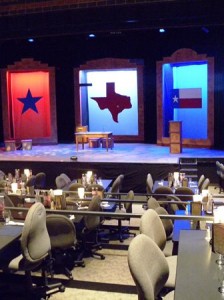 Linda Burton posting from Topeka, Kansas – “Acting is standing up naked and turning around very slowly.” That statement is attributed to Rosalind Russell; I found it on page 34 of my Sunday theater playbill. The actors I saw today were anything but naked – two men playing nineteen different roles with complete costume changes every few minutes. But it was “no holds barred” on the acting front as they switched back and forth between being old men and young, spiteful women and loving; women totin’ guns and men wearing tiaras; adding sagging breasts or bulging bellies or curly wigs and or ten-gallon hats as the role required. Was it a laugh-a-minute as Amber Windchime and Star Birdfeather paraded around? Did the audience roar when Arles Struvie or Thurston Wheelis took the stage? I was sharing a table; three lovely ladies who had season tickets were missing their
Linda Burton posting from Topeka, Kansas – “Acting is standing up naked and turning around very slowly.” That statement is attributed to Rosalind Russell; I found it on page 34 of my Sunday theater playbill. The actors I saw today were anything but naked – two men playing nineteen different roles with complete costume changes every few minutes. But it was “no holds barred” on the acting front as they switched back and forth between being old men and young, spiteful women and loving; women totin’ guns and men wearing tiaras; adding sagging breasts or bulging bellies or curly wigs and or ten-gallon hats as the role required. Was it a laugh-a-minute as Amber Windchime and Star Birdfeather paraded around? Did the audience roar when Arles Struvie or Thurston Wheelis took the stage? I was sharing a table; three lovely ladies who had season tickets were missing their  fourth friend today, so I sat with Madelyn and Joy and Betty as we enjoyed cheese-scrambled eggs and apricot-topped sweet rolls before the house lights went down. Our seats were grand; the third tier up and pretty much centered; the house was packed. The two men who carried the production onstage were Dan Decker, acting in his 11th show, and Thomas Hughes Jr, who has been performing here for
fourth friend today, so I sat with Madelyn and Joy and Betty as we enjoyed cheese-scrambled eggs and apricot-topped sweet rolls before the house lights went down. Our seats were grand; the third tier up and pretty much centered; the house was packed. The two men who carried the production onstage were Dan Decker, acting in his 11th show, and Thomas Hughes Jr, who has been performing here for 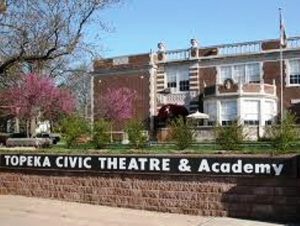 the last 17 years. Backstage, the costume crew of eight stood on point, ready for the split-second costume changes; the sound and lighting and stage crew were on their toes; all volunteers. The play was Red, White & Tuna; the setting was the 4th of July in Tuna, Texas; and the reality was the Sunday brunch matinee at the oldest community dinner theater in the country. Its proper name is Topeka Civic Theatre & Academy, and its mission statement begins “Bringing our diverse community together…” » read more
the last 17 years. Backstage, the costume crew of eight stood on point, ready for the split-second costume changes; the sound and lighting and stage crew were on their toes; all volunteers. The play was Red, White & Tuna; the setting was the 4th of July in Tuna, Texas; and the reality was the Sunday brunch matinee at the oldest community dinner theater in the country. Its proper name is Topeka Civic Theatre & Academy, and its mission statement begins “Bringing our diverse community together…” » read more
» posted on Friday, June 7th, 2013 by Linda Lou Burton
My Favorite Things
 Linda Burton posting from Topeka, Kansas – “I played golf.” That was Ryan’s answer to my question “What did you do today?” It was 5 PM and he was just getting the restaurant open; the hotel’s complimentary hot wings were bubbling over the sterno flame; the afternoon crowd was drifting in and conversations were beginning to take shape. I asked about the golf courses in the area and he ticked them off on his fingers, Cypress Ridge, Lake Shawnee, Forbes, the private courses too. “Golf is still my favorite thing,” he said. “and I started playing when I was seven. This is a great place for golfing.” Favorite things. A list was
Linda Burton posting from Topeka, Kansas – “I played golf.” That was Ryan’s answer to my question “What did you do today?” It was 5 PM and he was just getting the restaurant open; the hotel’s complimentary hot wings were bubbling over the sterno flame; the afternoon crowd was drifting in and conversations were beginning to take shape. I asked about the golf courses in the area and he ticked them off on his fingers, Cypress Ridge, Lake Shawnee, Forbes, the private courses too. “Golf is still my favorite thing,” he said. “and I started playing when I was seven. This is a great place for golfing.” Favorite things. A list was  coming together in my mind; Lee and James had told me their favorite thing in Topeka was drag racing; two young men, both named John, said theirs was hiking. John and John and dog Aztec were standing at the back of my car in the parking lot at Cedar Crest the day I toured the Governor’s Mansion; they’d just finished their hike on the property’s trail. We swapped stories; they wanted to hear about the Journey; I wanted to hear about Topeka. One John had moved from Michigan; the dog-owning John was born here; both enthusiastically endorsed life in Topeka, telling me the names of their favorite trails and their favorite fishing spots. Lee
coming together in my mind; Lee and James had told me their favorite thing in Topeka was drag racing; two young men, both named John, said theirs was hiking. John and John and dog Aztec were standing at the back of my car in the parking lot at Cedar Crest the day I toured the Governor’s Mansion; they’d just finished their hike on the property’s trail. We swapped stories; they wanted to hear about the Journey; I wanted to hear about Topeka. One John had moved from Michigan; the dog-owning John was born here; both enthusiastically endorsed life in Topeka, telling me the names of their favorite trails and their favorite fishing spots. Lee 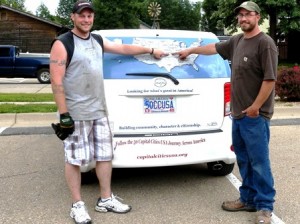 and James had spotted my car in a parking lot too; they were working at Old Prairie Town the day I visited there. They happily posed for pictures as I answered their questions about the Journey and they answered mine about Topeka; James told me the Heartland Race Track had the fastest drag strip in the world. “It’s what Topeka is known for,” he said. “I’ll be there Saturday night,” Lee added. “It’s my favorite thing to do.” » read more
and James had spotted my car in a parking lot too; they were working at Old Prairie Town the day I visited there. They happily posed for pictures as I answered their questions about the Journey and they answered mine about Topeka; James told me the Heartland Race Track had the fastest drag strip in the world. “It’s what Topeka is known for,” he said. “I’ll be there Saturday night,” Lee added. “It’s my favorite thing to do.” » read more
» posted on Wednesday, June 5th, 2013 by Linda Lou Burton
Digging Topeka
 Linda Burton posting from Topeka, Kansas – “It is novel, of Indian origin, and euphonious of sound.” Rev S Y Lum is purported to have said that about the word “Topeka” when he proposed it for the city’s name on January 1, 1855. He also claimed it was “a name not found in the list of post offices of the United States, nor in any lexicon of the English language.” Fry W Giles, one of the founders of Topeka, recorded that the founders liked the name – “since it is composed of three consonants
Linda Burton posting from Topeka, Kansas – “It is novel, of Indian origin, and euphonious of sound.” Rev S Y Lum is purported to have said that about the word “Topeka” when he proposed it for the city’s name on January 1, 1855. He also claimed it was “a name not found in the list of post offices of the United States, nor in any lexicon of the English language.” Fry W Giles, one of the founders of Topeka, recorded that the founders liked the name – “since it is composed of three consonants  alternating with three vowels, it is easy to pronounce.” It was adopted unanimously the next day. Topeka. I was in track-down mode, looking for the name origin of the city. Little did I suspect that potatoes would be part of the story I found. John Dunbar, a professor at Washburn University in the 1870’s, wrote that the name “Topeka” is composed of three words common in the languages of the Iowa, Omaha, and Kansa Indians; “to” means potato, “pe” means good, and “okae” means to dig. He believed that the word Topeka literally means “a good place to dig potatoes.” To dig potatoes? I had to dig deeper. Who originally used the name? Do potatoes really grow around here? I learned that Missionary Johnston
alternating with three vowels, it is easy to pronounce.” It was adopted unanimously the next day. Topeka. I was in track-down mode, looking for the name origin of the city. Little did I suspect that potatoes would be part of the story I found. John Dunbar, a professor at Washburn University in the 1870’s, wrote that the name “Topeka” is composed of three words common in the languages of the Iowa, Omaha, and Kansa Indians; “to” means potato, “pe” means good, and “okae” means to dig. He believed that the word Topeka literally means “a good place to dig potatoes.” To dig potatoes? I had to dig deeper. Who originally used the name? Do potatoes really grow around here? I learned that Missionary Johnston 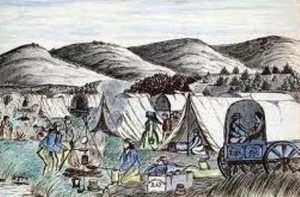 Lykins drew a map in 1849 while living at the Potawatomi Baptist Mission and used the word “Topeka” as the name of the Smoky Hill fork of the Kansas River. His map was published in 1853; likely the city founders had seen it when they named Topeka in 1855. And I found much written about the “Psoralea esculenta” or prairie potato, by explorers and settlers crossing the Kansas River and heading west. Like John Fremont, who led multiple surveying expeditions through western territories. » read more
Lykins drew a map in 1849 while living at the Potawatomi Baptist Mission and used the word “Topeka” as the name of the Smoky Hill fork of the Kansas River. His map was published in 1853; likely the city founders had seen it when they named Topeka in 1855. And I found much written about the “Psoralea esculenta” or prairie potato, by explorers and settlers crossing the Kansas River and heading west. Like John Fremont, who led multiple surveying expeditions through western territories. » read more
» posted on Monday, June 3rd, 2013 by Linda Lou Burton
Brown v Board
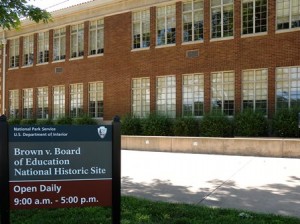 Linda Burton posting from Topeka, Kansas – “We conclude that in the field of public education the doctrine of ‘separate but equal’ has no place.” Such was the opinion written by Chief Justice Earl Warren in the 1954 Supreme Court Decision Brown v Board of Education. In a former schoolhouse on a side street in downtown Topeka, you can walk through a history of events that led up to that landmark decision, and what has happened since. The building, now a National Historic Site, once served as Monroe Elementary, and it still has a schoolhouse feel; in the hallway you pass drinking fountains set low enough for a kindergartner to reach;
Linda Burton posting from Topeka, Kansas – “We conclude that in the field of public education the doctrine of ‘separate but equal’ has no place.” Such was the opinion written by Chief Justice Earl Warren in the 1954 Supreme Court Decision Brown v Board of Education. In a former schoolhouse on a side street in downtown Topeka, you can walk through a history of events that led up to that landmark decision, and what has happened since. The building, now a National Historic Site, once served as Monroe Elementary, and it still has a schoolhouse feel; in the hallway you pass drinking fountains set low enough for a kindergartner to reach; 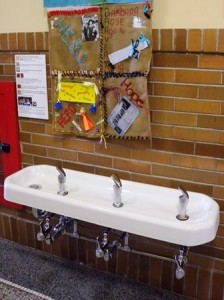 there’s the smell of chalk, and echoes in the hall. Monroe Elementary was one of four all-black elementary schools in Topeka when it was selected by NAACP strategists in 1950 as part of a larger plan to bring the “separate but equal” doctrine into the courts. With NAACP guidance thirteen sets of parents agreed to attempt to enroll their children in white schools, not expecting to be admitted, and then file complaints. Linda Brown (b 1942) was a third grader at Monroe at the time her
there’s the smell of chalk, and echoes in the hall. Monroe Elementary was one of four all-black elementary schools in Topeka when it was selected by NAACP strategists in 1950 as part of a larger plan to bring the “separate but equal” doctrine into the courts. With NAACP guidance thirteen sets of parents agreed to attempt to enroll their children in white schools, not expecting to be admitted, and then file complaints. Linda Brown (b 1942) was a third grader at Monroe at the time her  parents Leola and Oliver Brown decided to participate; alphabetically “Brown” was the first name on the lawsuit; forever after Brown v Board of Education is the name associated with the end of public school segregation in the United States. The full story, however, is multi-layered and complex; the exhibits in the Brown v Board of Education National Historic Site take you through the key points, even going further back in time than the 1896 Supreme Court decision when Plessy v Ferguson put the “separate but equal” doctrine legally into place. Race and the American Creed is the place to start; it’s a movie in the auditorium. » read more
parents Leola and Oliver Brown decided to participate; alphabetically “Brown” was the first name on the lawsuit; forever after Brown v Board of Education is the name associated with the end of public school segregation in the United States. The full story, however, is multi-layered and complex; the exhibits in the Brown v Board of Education National Historic Site take you through the key points, even going further back in time than the 1896 Supreme Court decision when Plessy v Ferguson put the “separate but equal” doctrine legally into place. Race and the American Creed is the place to start; it’s a movie in the auditorium. » read more
» posted on Saturday, June 1st, 2013 by Linda Lou Burton
If The Creek Don’t Rise
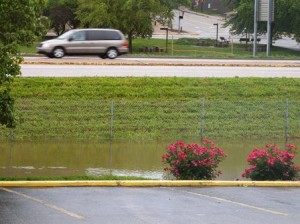 Linda Burton posting from Topeka, Kansas – The morning light in Jefferson City revealed water. The weather radio was exhausted after a night of blaring out flood warnings and thunderstorm realities and tornado possibilities. At least, I was exhausted from listening to it. The front desk had warned all guests to park in the back lot, assuring us the hotel wouldn’t flood but the street out front probably would. It did. I threw on yesterday’s clothes and headed outside for a walk around the premises, glad to discover it was only the front street under water just past the
Linda Burton posting from Topeka, Kansas – The morning light in Jefferson City revealed water. The weather radio was exhausted after a night of blaring out flood warnings and thunderstorm realities and tornado possibilities. At least, I was exhausted from listening to it. The front desk had warned all guests to park in the back lot, assuring us the hotel wouldn’t flood but the street out front probably would. It did. I threw on yesterday’s clothes and headed outside for a walk around the premises, glad to discover it was only the front street under water just past the 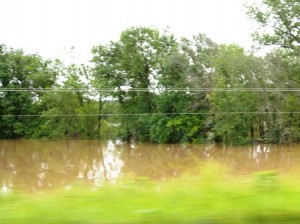 rose bushes; from the back parking lot I could exit uphill and make it to the highway just fine. “It’s a go,” I told the cats, as I hauled the cart into the room. One shower and four cartloads later, we were on the road, in good faith that last night’s line of storms was far to the east, and the roads west had not been breached by Missouri River overflow. It was 224 miles to Topeka; 30 miles to Columbia on US 63 (cross the Missouri River once); then I-70 for 128 miles (cross the Missouri River twice) to the Kansas state line (cross the Kansas
rose bushes; from the back parking lot I could exit uphill and make it to the highway just fine. “It’s a go,” I told the cats, as I hauled the cart into the room. One shower and four cartloads later, we were on the road, in good faith that last night’s line of storms was far to the east, and the roads west had not been breached by Missouri River overflow. It was 224 miles to Topeka; 30 miles to Columbia on US 63 (cross the Missouri River once); then I-70 for 128 miles (cross the Missouri River twice) to the Kansas state line (cross the Kansas  River just before it flows into the Missouri). Luck was with us; the Missouri looked angry and long stretches of lowlands lay underwater, but all roads were open. Independence lured us to stay in Missouri a little longer. The Harry S Truman Presidential Library! The National Frontier Trails Museum! Kansas City, Missouri offered the Kansas City Royals and tall buildings and the American Jazz Museum. But no stopping; it was westward ho to the Sunflower state, hoping to find Toto in Kansas today. And sure enough, the sun came out. » read more
River just before it flows into the Missouri). Luck was with us; the Missouri looked angry and long stretches of lowlands lay underwater, but all roads were open. Independence lured us to stay in Missouri a little longer. The Harry S Truman Presidential Library! The National Frontier Trails Museum! Kansas City, Missouri offered the Kansas City Royals and tall buildings and the American Jazz Museum. But no stopping; it was westward ho to the Sunflower state, hoping to find Toto in Kansas today. And sure enough, the sun came out. » read more
